Wet-Bulb Temperatures: The Hidden Heat Metric You Need to Know
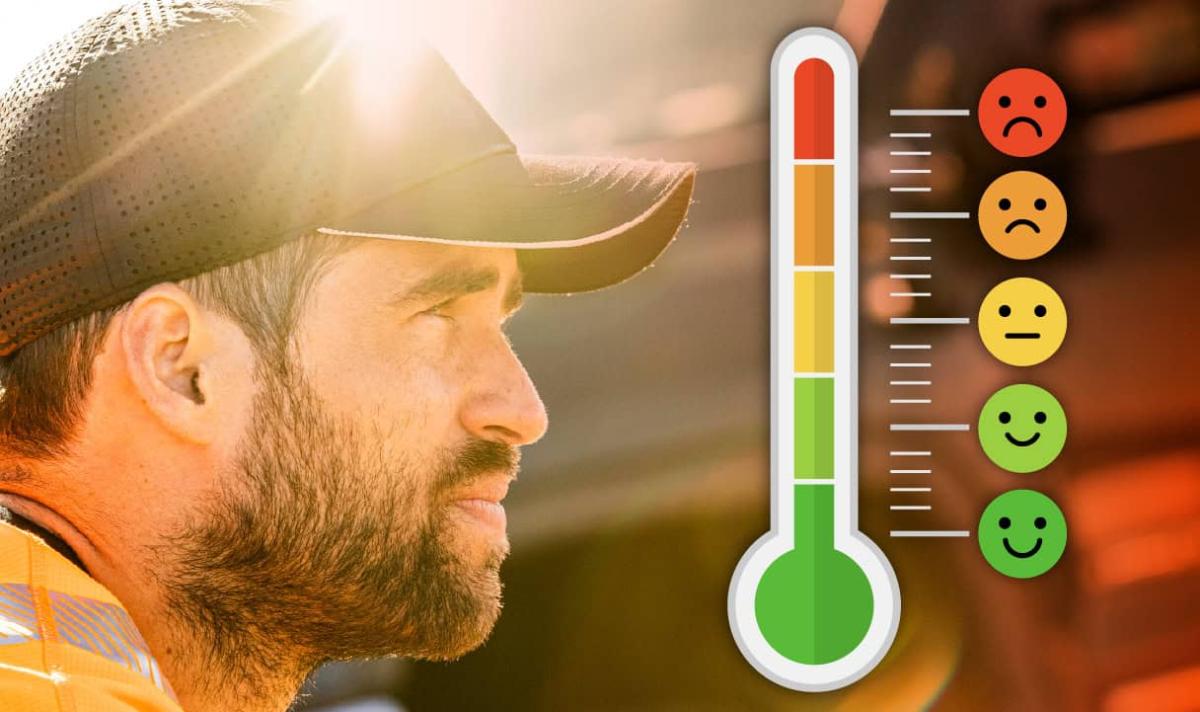
Your weather app says 90°, but your body’s calling BS. There’s a deadlier number at play—one many have never even heard of. And that’s a problem.
The way our bodies experience heat is a complex combination of many different factors, such as humidity, sunlight, cloud coverage and air movement. We can’t possibly begin to understand how hot it really is by a simple measure of the true air temperature.
Enter Wet Bulb Globe Temperature.
What Is a Wet Bulb Globe Temperature?
Wet Bulb Globe Temperature (WBGT) is a comprehensive measurement of what the temperature truly is, and a trigger for action should heat stress be of concern.
Heat stress is, and has been, a leading cause of death on jobsites, in athletics and beyond. With the temperature of our globe constantly increasing, heat stress is only becoming more of a pressing issue for workers, runners and pretty much anyone who goes outside. And it is not going away.
WBGT was invented in the 1950’s to combat heat stress and heat-related illness outbreaks on United States Army and Marine Corps Training Camps, according to the National Library of Medicine. Taking into account all of the different factors that play a role in high-heat situations allowed leaders to know when to implement precautions and in turn, prevent illnesses and death.
WBGT is a resource to limit heat stress. It offers us a way to measure that concern and take precautionary measures accordingly. And it is crucial that we use it.
Why Should I Monitor Wet Bulb Globe Temperature?
Monitoring WBGT is crucial for preventing heat-related illnesses and ensuring peak performance in environments where heat stress is a significant risk—like construction, agriculture or other physically demanding industries––and traditional temperature readings don’t give a full picture of how hot it truly feels to the body.
High WBGT values can indicate dangerous levels of heat stress, especially when humidity is high, making it harder for the body to cool itself through sweating. This can lead to any number of heat-related illnesses which negatively impact performance and safety, from heat exhaustion and dehydration to heat stroke and death.
According to Occupational Health & Safety, "by 2030, heat stress could cut 2.2% of global working hours, which would be equivalent to the output of 80 million full-time jobs." By monitoring WBGT, employers can make informed decisions about work/rest schedules, hydration and protective measures, reducing the risk of heat stress and helping to maintain both safety and productivity in high-heat conditions.
How Do I Measure Wet Bulb Globe Temperature?
There are three components of wet bulb globe temperature:
- Air temperature and air movement
- Relative humidity
- Sun angle and cloud coverage
A combination of these three factors offer an accurate reading of the outside conditions. When looking at temperature, these factors offer insight into how the heat is interacting with the human body. It offers a holistic view of how and why different temperatures or weather conditions make us feel “hotter” at a faster or more dangerous rate.
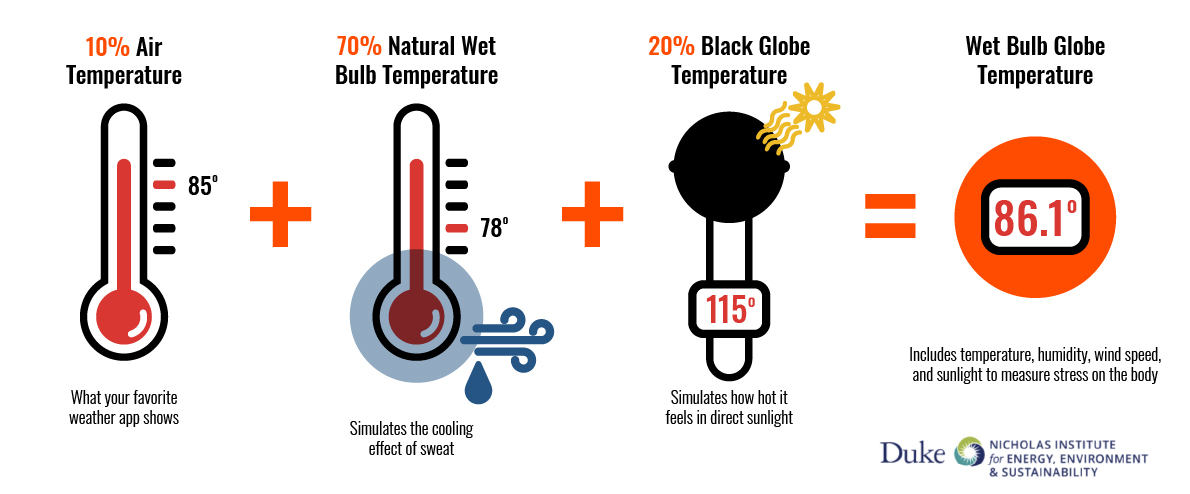
Measuring WBGT requires a special instrument, usually known as a WBGT meter or thermometer. This instrument measures different environmental factors simultaneously and then combines them to give the user a holistic view of the outside conditions and what their body is likely experiencing should they be spending any amount of time outdoors.
According to the Korey Stringer Institute at the University of Connecticut, the device includes three components: a thermometer with a wet wick to measure the wet bulb temperature, which in turn measures the humidity. A black globe measures radiant heat, and finally, a true thermometer measures the air temperature.
The readings of these three components are then combined using the formula below that considers the relative importance of each of the factors in the overall WBGT. Then, the instrument spits out the accurate reading of the environmental temperature, signaling to the user when it is time to take precautions or when work can continue safely.
WBGT = 0.7(Tw) + 0.2(Tg) + 0.1(Td)
- WBGT = Wet Bulb Globe Temperature
- Tw = Wet Bulb Temperature
- Tg = Black Globe Temperature
- Td = Dry Bulb Temperature
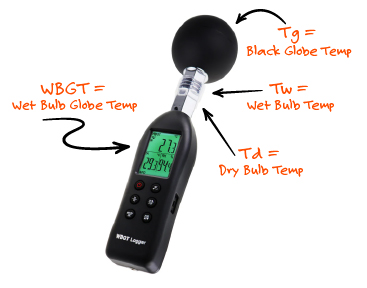
What is Considered a Dangerous Wet Bulb Globe Temperature?
When it comes to working in high-heat environments, the WBGT is your key to keeping things safe—and ANSI/ASSP and OSHA are on the same page about that. Both organizations recognize WBGT as a crucial factor in assessing heat stress risks on jobsites, especially in places where the heat is a daily challenge.
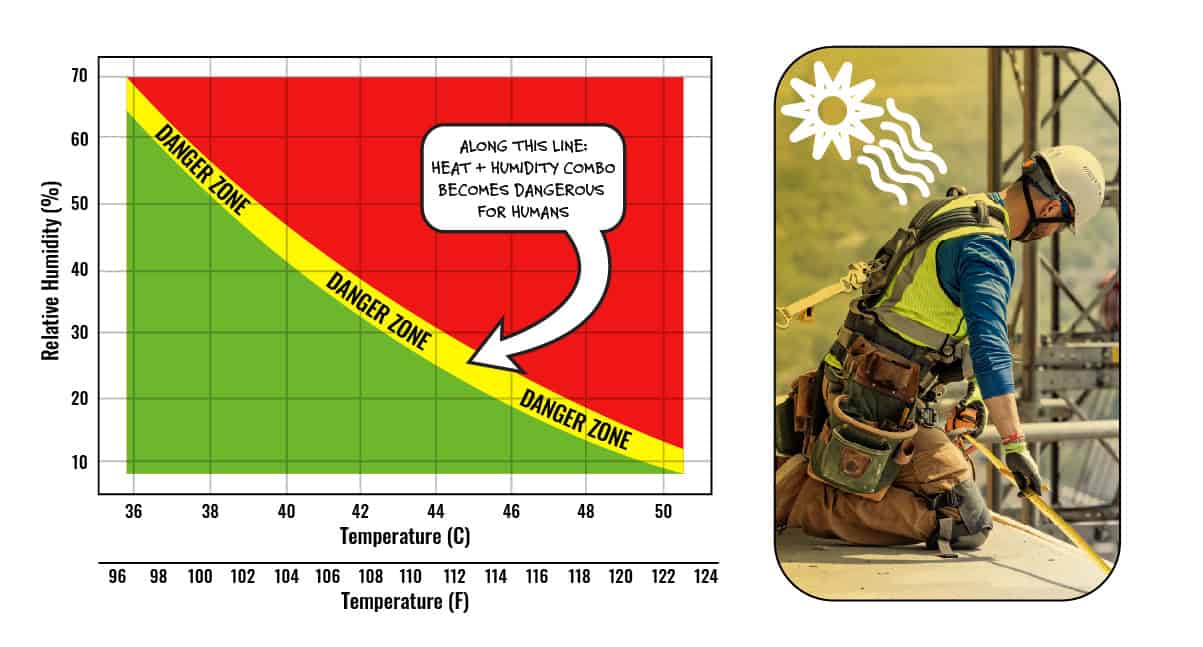
There are clear temperature thresholds that, when surpassed, can quickly lead to heat stress if the proper precautions aren't taken. For instance, ANSI/ASSP highlights that once the WBGT hits 70°F, managers should take action with heat stress prevention plans. This is the signal to implement key measures like providing shade, regular breaks, hydration and personal protective equipment (PPE) to avoid heat-related illnesses—or worse.
OSHA echoes the importance of temperature awareness, emphasizing when it's critical to step up preventative efforts. According to them, the "initial heat trigger" occurs at a heat index of 80°F or when the WBGT reaches the NIOSH Recommended Alert Limit. This is the temperature zone where action must be taken, before heat stress becomes a real danger to workers.
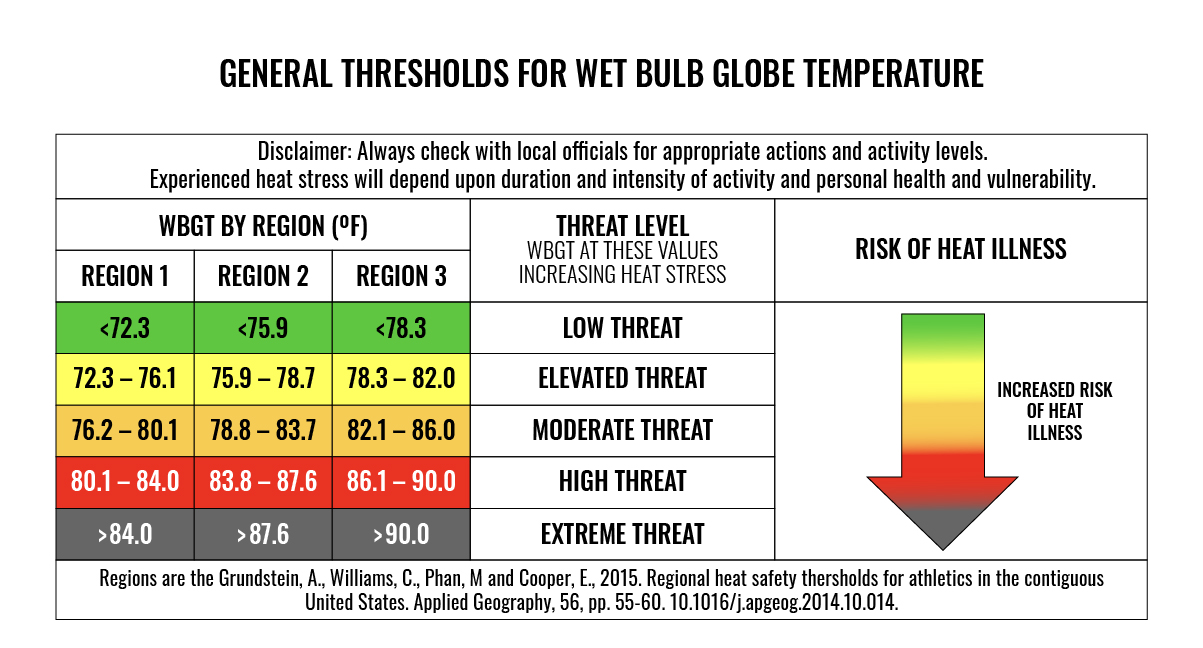
What Should I Do When Wet Bulb Globe Temperatures Reach Dangerous Levels?
When it comes to preventing heat stress in environments with high WBGT, proactive measures are essential. First and foremost, monitoring WBGT regularly with a reliable meter will help identify potential heat stress risks. When the WBGT reading exceeds the thresholds described above, it's crucial to adjust work schedules and take action to minimize heat-exposure.
For example, provide workers with regular rest breaks in cool, shaded areas and ensure hydration with water or electrolyte-replenishing drinks. Wearing lightweight, breathable clothing and using cooling gear like towels, hats, vests or fans can help reduce body heat. It’s also important to gradually acclimate individuals to hot conditions, especially when transitioning from cooler environments.
For more extreme cases, such as WBGT readings that exceed 85°F (29.5°C), consider modifying work duties, increasing rest intervals or halting outdoor activities altogether to avoid serious heat-related illnesses. By keeping a close eye on WBGT and acting accordingly, you can ensure a safer working environment for everyone involved.
What Do People Get Wrong About Wet Bulb Globe Temperature?
Despite its importance, there are several misconceptions about WBGT that can lead to confusion or mismanagement of heat stress risks. One common misunderstanding is that WBGT is just another way of measuring temperature, but in reality, it’s a more nuanced index that accounts for conditions beyond just the air temperature. This makes it far more accurate in assessing how heat affects the human body.
Another misconception is that WBGT only matters in extremely hot environments, when in fact, high humidity or exposure to direct sunlight can push WBGT values into dangerous ranges even in moderate temperatures.
Some people also assume that WBGT only applies to outdoor activities, but it’s equally relevant indoors, especially in workplaces with poor ventilation or high equipment heat.
Finally, many believe that heat stress prevention based on WBGT is a one-size-fits-all approach, when, in reality, precautionary measures should be tailored to specific activities, the fitness level of individuals and environmental conditions. Understanding the true nature of WBGT is key to effectively managing heat stress and preventing related health risks.
How Can I Prepare for High Wet Bulb Globe Temperatures?
Carelessness, machismo and misinformation are at the center of thousands of heat-related injuries every year even though they’re absolutely, positively, 100% preventable with just a little planning and brainpower.
Here are some simple ways to work smart in the heat:
- Know the Signs of Heat-Related Illness
- Weakness, confusion, rash… any of these sound familiar? Find a shady spot + cool drink ASAP. Be on the lookout for co-workers experiencing any of these, too.
- Ease Into It
- 70% of heat-related illnesses occur within the first few days of extreme heat. Every worksite should have an acclimatization protocol for newbies, those that haven’t been to work for a while or if there’s been an extreme shift in temp.
- Keep on Chuggin’
- OSHA recommends workers gradually replace lost fluids with 5-7oz of water every 20 minutes. Urine color is your number one (Ha! See what we did there?) indicator of hydration levels.
- Break It Up
- Setting the right working hours and breaks schedules for workers in the heat is critical. A supervisor on your staff should be actively enforcing these break times, and ensuring the break area provides shade and easy access to water.
- Find Your Chill
- Along with the biggies of water, rest and shade, experts recommend cooling PPE (vests, towels, shirts, headbands etc) as a simple way to maintain safe body and skin temps throughout the shift.
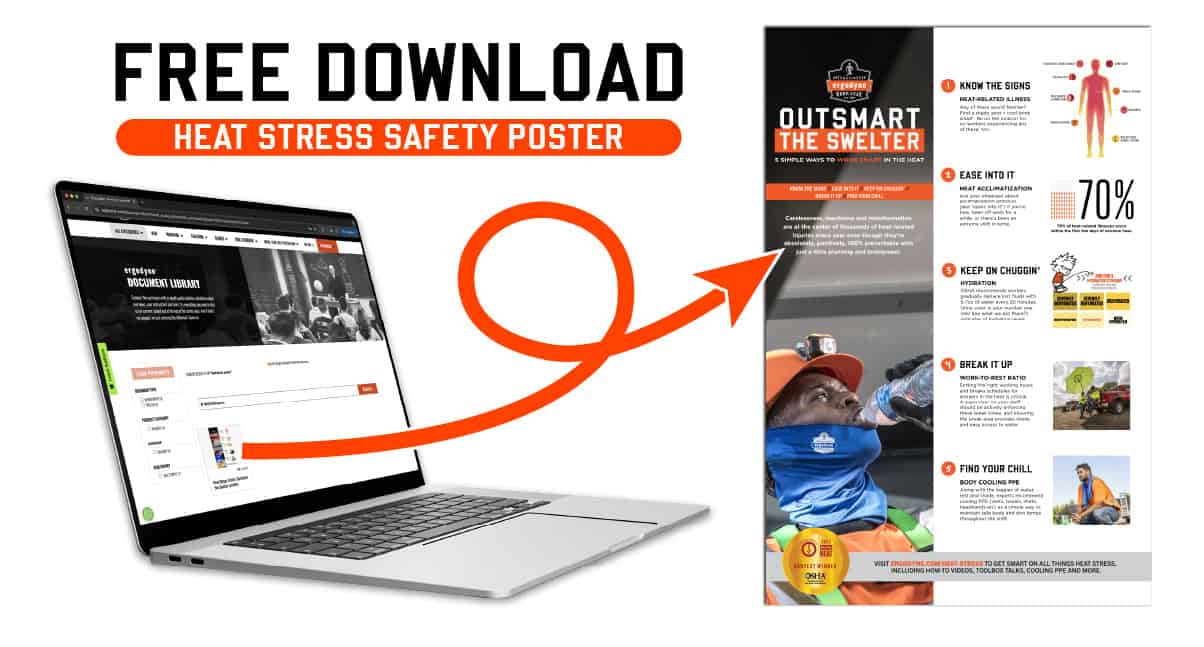
FAQ
No, wet bulb temperature and dew point are not the same. Wet bulb temperature measures the lowest temperature that can be reached through evaporative cooling, factoring in humidity and air movement. Dew point, on the other hand, is the temperature at which air becomes fully saturated with moisture, leading to condensation. While both relate to humidity, wet bulb temperature accounts for heat stress risks, while dew point focuses on moisture content in the air.
A wet and dry bulb thermometer, also known as a psychrometer, measures relative humidity and air temperature. The dry bulb thermometer records the ambient air temperature, while the wet bulb thermometer, wrapped in a water-soaked wick, measures the cooling effect of evaporation. The difference between the two readings helps determine humidity levels and wet bulb temperature.
Indoor wet bulb temperature refers to the wet bulb reading taken in an indoor environment. It accounts for temperature, humidity, and air movement but does not factor in direct solar radiation, unlike outdoor measurements. It is useful for assessing heat stress risks in workplaces like factories, warehouses, and kitchens where heat and humidity are concerns.
Wet bulb temperature is used to assess heat stress risk in workers, athletes, and military personnel by indicating how well sweat can evaporate to cool the body. It plays a critical role in Wet Bulb Globe Temperature (WBGT) calculations, which guide safety protocols for working in extreme heat. It is also used in meteorology, HVAC systems, and industrial processes to evaluate cooling efficiency and environmental conditions.

